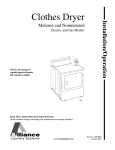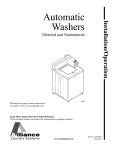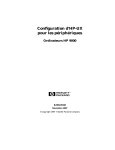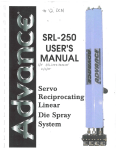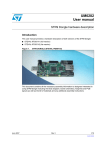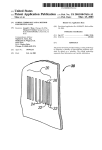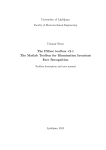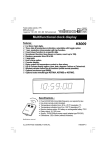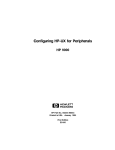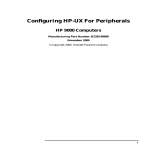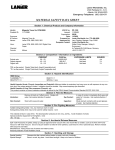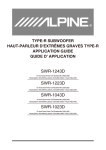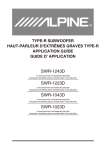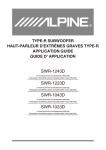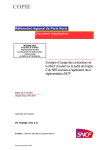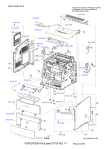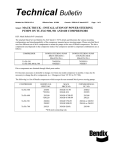Download Electronic control system for a pouch packaging machine
Transcript
United States Patent [19] [11] 4,318,431 Evans [45] Mar. 9, 1982 [54] ELECTRONIC CONTROL SYSTEM FOR A POUCH PACKAGING MACHINE OTHER PUBLICATIONS “Service Manual-Piston Filler”, FMC Corporation [751 Inventor: Susan D. Evans, Stamford, Conn. [73] Assignee: RJR Foods, Inc., San Francisco, Calif. (Ser. Nos_ 08851300 and 579B50), see p. 5. Primary Examiner—Houston S. Bell, Jr. Attorney, Agent, or Firm—Grover M. Myers [57] ABSTRACT An electronic control system is described to control the [2 1] Appl. No.: 214,388 operation of a positive displacement piston ?ller used for dispensing sauce or a suitable liquid into a ?exible pouch which is controlled in movement by means of a Bartelt packaging machine. The electronic control sys tem exerts‘ control over the opening and closing of a dispensing plunger, a rotor valve and a product delivery piston associated with the sauce ?ller apparatus. A 122] Filed: [51] [52] Int. Cl.3 .............................................. .. B65B 3/04 141/114; 141/166; 53/493; 222/70 blow-off timing sequence is further controlled to assure [58] Field of Search ........... .. 141/10, 1, 114, 313-317, that a blast of pressurized air enters the dispensing head Dec. 8, 1980 US. Cl. ...................................... .. 141/90; 141/91; l4l/129-l92, 85~93, 98, 250-284; 53/493, 562, of the sauce ?ller at the most optimum time to assure 407; 222/70 reliable cleaning of the top portion of the pouch prior to sealing. The control system employs separate timers [56] References Cited U.S. PATENT DOCUMENTS 2,649,674 4,081,942 8/1953 4/1978 Bartlet ................................. ., 53/562 Johnson .............................. .. 53/407 42 which serve to enable control of each of the above described operations in one hundredths of a second to enable precise regulation of each phase of the ?ll cycle. 17 Claims, 6 Drawing Figures U.S. Patent Mar. 9, 1982 Sheet 4 of4 4,318,431 _ _ E6 _ _ _ _ _ _ Qudwg? _ _ _ _ _ _ _ _ _ _ _ _ _ UL}3.3.3..3 4 _ _ _ _ _ _ _ _ 1 4,318,431 2 cognizant of the problem and do employ a blow-off ELECTRONIC CONTROL SYSTEM FOR A POUCH PACKAGING MACHINE operation. In any event, it has been a continuous problem in sauce ?lling operations to drive the equipment at high BACKGROUND OF THE INVENTION This invention relates to an electronic control system speed in order to ?ll as many pouches per minute as possible, and to further assure that when operation oc for use with apparatus for ?lling ?exible pouches with a curs at high speed, that the blow-off is implemented at product. the proper time in the cycle. Essentially, if blow-off The use of pouches which are fabricated from a ?exi ble material such as a suitable plastic-foil laminate is occurs too early or too late in the cycle, its effectiveness well known in the art. In particular, this technique has been employed with food products and the canning industry is fully cognizant of many problems and solu tions in regard to ?lling a pouch or container with food is substantially reduced. In prior art sauce ?lling operations, a useful mecha nism which is available has been referred to as the RAQUE ?ller. The Raque ?ller apparatus is located at a ?lling station location associated with a Bartelt ma in a relatively automated procedure. In regard to this, 5 chine. The ?ller employs a hopper which contains a there exists many patents which show and describe the sauce. The sauce is retracted from the hopper through a typical problems involved in processing and packaging food in ?exible pouches. rotor valve by means of a product piston and eventually Perhaps one of the most well known machines for performing such an operation is the subject matter of US. Pat. No. 2,649,674 issued on Aug. 25, 1953 to H. L. Bartelt entitled “PACKAGING MACHINE”. This machine has been employed extensively in the packag ing industry. In this machine, the pouches are formed from a strip of material and the formed pouches are advanced through various ?lling stations where a prod uct is introduced into the pouches. After product intro dispensed by means of a dispensing piston. The Raque ?ller is controlled in operation by a completely pneu matic system. Essentially, the control system uses pres surized air to perform all logic operations. Air logic has been widely employed in conjunction with packaging operations and has been extensively used with the Raque ?ller. There are many disadvantages in regard to using air logic in food processing and especially where a liquid as a sauce is being dispensed. As one can imagine, impuri ties in the air can jam ?lters and mufflers associated with such systems, thus causing many failures and re ductions in air pressure. Apart from these consider ations is the fact that air logic operates at relatively slow speeds which are a function of the velocity of a sound tively long shelf life. The ?nal operation requires seal pressure wave. Accordingly, the systems do not permit ing the pouch to thereby contain the ?nal food product. The “BARTELT” machine, as indicated, is an ex 35 rapid pouch ?lling operations and are dif?cult to con trol in regaard to timing and operation. tremely ef?cient and reliable apparatus and is described By employing an electronic system, one can achieve in detail in the above noted patent. ~ more rapid operation and relative immunity from many Patents such as US. Pat. No. 4,081,942 issued on Apr. problems associated with air logic. However, electronic 4, 1978 and entitled “MACHINE AND METHOD control of such apparatus is also extremely dif?cult to FOR FILLING, INTRODUCING STEAM INTO, duction by one or more ?lling stations, the pouches are advanced to other locations where steam may be intro duced in order to remove air from the pouch and'to enable the product to be packaged in an oxygen free environment to enable the product to possess a rela AND SEALING FLEXIBLE POUCHES” assigned implement due to the fact that the packing machine such as the Bartelt machine is not synchronized to the operation of the ?lling station and if one desires to achieve more rapid operation, one has to be assured that tus which is employed in conjunction with such ma chines to increase the ef?ciency and provide desired 45 the entire ?lling sequence will occur within. a predeter mined interval and must occur according to the operat operating characteristics. . to the Rexham Corporation of New York as well as many other patents describe various additional appara In any event, depending upon the nature of the prod uct which is being packaged, one experiences many different types of problems. In particular, such ma chines have been employed for packaging sauce type food products in pouches. It is a major desire of any packaging operation to ?ll the pouches or containers as rapidly as possible, while further assuring that the ing characteristics of the packaging machine. proper quantity of food is emplaced in each pouch. In conjunction with such desired operating characteristics, is the further problem of providing a good seal for such packaging machine and which system is adapted to pouches when food materials such as liquids or sauces are introduced into the ?exible pouches. As is known in the art, the nature of the retort pouch is such that the seal qualtity is critical. Top seal accept ability is affected by the presence of blemishes from occluded drops of liquid. Such blemishes can occur from splattered sauce or condensed steam. In a sauce In order to accomplish electronic control, the appara tus must be capable of directly inferfacing with existing packaging machines to assure reliable and optimum operation. Hence, it is a general aim of the present in vention to provide a new and improved electronic con trol system to be used in conjunction with a pouch control the operation of a sauce ?ller apparatus to pro vide a system capable of ?lling pouches with sauces or liquids at relatively high rates. A further object of the present system is to opti mumly control blow-off during a ?lling cycle to assure an acceptable seal quality for the pouch. BRIEF DESCRIPTION OF THE INVENTION The invention is a sauce ?ller control apparatus for ?lling operation, the droplets of sauce which may effect controlling the sequence of operation of a ?lling appara the seal quality can be minimized by employing a prop 65 tus having product means for receiving and expelling erly timed blast of air at the dispenser tip. This is re the material to be dispensed, dispensing means for de ferred to in the art as blow-off. The prior art techniques positing the remaining material, valve means selectively for introducing sauce or a liquid into a retort pouch are connecting the product means with a material source 3 4,318,431 when the valve is in a ?ll position and with the dispens ing means when the valve is in a dispensing position, and actuating means responsive to electrical signals for 4 The pouch 10 may be fabricated during the operation of the packaging machine. In most respects, the packag ing machine is similar in construction to that machine disclosed in US. Pat. No. 2,649,674 (Bartelt) and thus controlling the product means, dispensing means and valve means. The control apparatus comprises a ?rst certain elements of the machine will not be described in detail as one can ascertain the complete operation of the timing means responsive to an initiating electrical signal packaging machine by reference to the cited patent. As indicated in FIG. 1, it is suf?cient to state that each pouch 10 is adapted to be gripped releasably at its for providing a ?rst electrical signal at the end of a ?rst time interval following receipt of the initiating signal; a ?rst circuit means for supplying the ?rst signal to the actuating means to cause the product means to assume side margins by leading and trailing clamps 13 and 14 its receiving position, a second timing means responsive to the ?rst signal for providing a second electrical signal at the end of a second time interval following receipt of which are carried on a chain conveyor 15. The chain conveyor 15 is adapted to be advanced by a suitable drive mechanism as explained in the above noted patent. the ?rst signal; a second circuit means for supplying the As the chain 15 is advanced, the pouches 10 are moved second signal to the actuating means to cause the valve 15 into and momentarily dwell at a series of horizontally means to assume its dispensing position; trigger circuit spaced stations where packaging operations as ?lling, means responsive to the second signal and an externally steaming and sealing are performed on the pouches. In supplied signal for supplying a triggering signal to cause the present instance, the pouches 10 are advanced in said dispensing means to open to a receiving position; a spaced edgewiwse relation and are held with their open third timing means responsive to the triggering signal for providing a third electrical signal at the end of a third time interval following receipt of the triggering 20 ends facing upwardly. Located above the central pouch 10 is a sauce ?ller location 20. The sauce ?ller is a well known Raque ?ller signal; a third circuit means for supplying the third whose operation is fully known to those skilled in the signal to the actuating means to cause said product art and which will be briefly described herein. 25 means to assume its expelling position; a fourth timing There is shown a main hopper 21 which acts as a means responsive to the third signal for providing a reservoir for a liquid or sauce 22. The hopper 21 is of a fourth electrical signal and a reset electrical signal to truncated cone con?guration having a narrow bottom reset all of the timing means at the end of a fourth time portion directed into a rotor valve 24. The rotor valve interval following receipt of the third signal; a fourth 30 24 is shown in detail in FIG. 4A and FIG. 4B. The rotor circuit means for supplying the fourth signal to the valve, when rotated to a ?ll position, shown in FIG. 4A actuating means to cause the dispensing means to as sume a non4receiving position and to cause the valve means to assume its ?ll position and to the ?rst timing means as the initiating signal. will enable communication between the hopper 21 and a product cylinder 26. When rotated to a dispensing position shown in FIG. 4B the rotor valve enables com 35 munication between the product cylinder 26 and a dis pensing tube 29. The rotor valve 24, as above described, has the inlet, outlet and ?ll apertures arranged in a “T” Above-mentioned and other features and objects of con?guration. As indicated, such valves are well known this invention will become more apparent by reference in the art. In the present invention the positional control to the following description taken in conjunction with 40 of the valve is afforded by a stepper motor or coil, the accompanying drawings, in which: which upon reception of a suitable biasing signal, will FIG. 1 is a partial perspective and schematic view of actuate a valve to admit pressurized air to the Raque a pouch packaging machine employing an electronic supplied air motor to move the valve into any one of its control system for a sauce ?lling operation; operating positions. FIG. 2 is an electrical schematic diagram of the elec 45 Shown coupled to the inlet port 240 of the rotor tronic timing and control logic according to this inven valve 24 is the product cylinder 26 having located therein a product piston 27. The piston 27 is coupled to tron; FIG. 3 is a schematic diagram of a blow-off control a piston rod 28 and is controlled by the product piston BRIEF DESCRIPTION OF THE DRAWINGS circuit according to this invention; FIG. 4A is a detailed schematic drawing of the rotor solenoid and associated valve and air motor 31. As is known, the piston 27 can be in a retracted receiving position as shown or in an extending expelling position valve shown in FIG. 1 in its ?ll position; FIG. 4B is a detailed schematic drawing of the rotor (shown in dashed lines). The piston 27 will traverse valve shown in FIG. 1 in its dispensing position; and from the extended to the retracted position upon appli FIG. 5 is a detailed schematic drawing of the dispens cation of a suitable potential to the solenoid 30. ing plunger shown in FIG. 1 in its non-receiving, or 55 Coupled to the outlet port of the rotor valve 24 is the dispensing position. dispensing tube 29. The tube 29 is fabricated from a ?exible hose material and provides an output path for DETAILED DESCRIPTION OF THE receiving product, as the sauce from the product dis INVENTION pensing cylinder 26, as will be described. Shown in the drawings for purposes of illustration, 60 The dispensing tube 29 is coupled to an input port of the invention is embodied in a packaging machine for a dispensing head 30. The dispensing head 30 is part of forming ?lling and sealing pouch packages such as 10. the Raque sauce ?ller. Accordingly the dispensing head The pouch 10 is usually made from a single or compos is controlled to move in the vertical direction as indi ite sheet of ?exible material such as a suitable plastic as cated by arrows 32. When the dispensing head 30 is a polyole?n which may contain a middle laminate of 65 moved downwardly, the opened bottom end 34 moves aluminum foil with an outer laminate of a polyester. into the open top of the pouch 10. As indicated above, The fabrication and composition of pouches as 10 are the vertical movement of the dispensing head is strictly extremely well known in the ?eld. under control of the packaging machine through a cam 5 4,318,431 shaft and cam follower as described in the above noted patent. Located within the dispensing head is a dispensing plunger 34, shown in detail in FIG. 5. The plunger 34 is pouch is positioned below the dispensing head and the operation is repeated, as will be described, for each pouch carried by the chain conveyor system associated coupled via a suitable rod 35 to a solenoid coil and an associated valve and air motor 36 referenced as dispense plunger. The dispensing plunger 34 has a central aper ture 38 through which a blast of pressurized air is di rected during a blow-off procedure, as will be ex plained. 6 aperture 38 and serves to force any remaining liquid droplets to be directed into the pouch. The above described operation occurs when the with the Bartelt machine. Referring to FIG. 2, there is shown an electrical schematic diagram of the electronic timing and control 10 logic 50 depicted in FIG. 1. Where applicable, similar reference numerals have been retained to designate Located in a sidewall of the dispensing head 30 is an inlet aperture 40 which is coupled via a ?exible hose 41 similar functioning parts. In the schematic, two parallel lines represent a nor to a source of pressurized air 42. A valve 43 under the mally opened contact, while two parallel lines with a transverse line drawn through represent a normally control of the electronic system to be described pro vides the timing for the blow-off operation and hence, determines the duration of the opening of the valve 43, closed contact. The symbols for indicating a relay coil are nCR, where N is a positive integer. A contact associated with Shown located to the left of the central pouch 10 is a that coil is designated as nCRx, where x is a positive proximity switch 44 also designated as CRF-2. As will integer. A solid state relay is indicated as nSSR with a be described, this switch may be a microswitch and is contact of that relay indicated as NSSRx. A timer is activated by a pouch which enters the area at which the depicted as nTR with a contact of the timer indicated as dispensing head 30 is located. The switch 44 serves to nTRx. Thus, in referring to FIG. 2, the top solid state aid in controlling the sequence of operations to be de relay is designated as ISSR as compared to 2SSR and scribed. 25 3SSR. A contact relay ISSR is designated as 1SSR1 and A further switch 45 designated as LSSF is also is normally opened. In the embodiment described, it shown. The switch 45 is a limit switch and is operated will be assumed that the machine advances the pouches from the main cam shaft of the Bartelt machine and from station to station once each second. operates in relation to the speed of the machine to pro As can be seen from FIG. 2, 1SSR is in series with vide a limit operation indicative of a pouch being within contact 2CR1 which is normally closed and which is the ?lling station area. This switch, as will be further associated with relay coil 2CR. A timer 1TR is depicted described, also controls the sequence of operations to be by a circle and its contact is designated as lTRl. Next as will be described. performed by the electronic timing and control logic. to this contact is a designation 00x. Since contact 1TR1 As seen from FIG. 1, both switches 44 and 45 inter is controlled by the timer lTR, the designation 00x is face with the electronic timing and control logic mod 35 determined as follows: Contact lTR 1 is a normally ule 50. As will be explained, the module 50 provides an opened contact and hence, the ?rst 0 indicates this. output which controls the blow-off time via valve 43, ' When the timer is running, the second 0 indicates that provides an output which controls the rotor valve 24, the contact is also normally opened. When the timer runs out, the contact is closed and hence, the third piston solenoid 31 and the dispenser plunger solenoid 40 symbol being x represents contact closure. This termi 36. nology is used beneath each contact which is timer Also depicted in FIG. 1 is a manual switch 51 desig controlled. nated as on-off or CRST. In order to provide the timing The above noted nomenclature has been employed in and control sequence, the switch 51 is in its closed posi lieu of numbers to enable one to clearly follow the provides a further output which controls the product tion during system operation. With the above general description of the apparatus in mind, it is believed that an explanation of the basic 45 system operation, which otherwise would be extremely dif?cult. As seen from FIG. 2, the control coils for the dis penser plunger solenoid 36, the rotor valve 24 and the product piston 31 are depicted by a resistor notation. It sequence involved is warranted. As one can ascertain, it is an object of the ?lling operation to insert a predetermined amount of sauce or is indicated at the on set that based on the well known liquid 22 into the pouch 10. In order to do so the follow ing minimum operations must occur: The product cylinder, at a suitable time in the se quence, must be loaded with product through the rotor operation of such components, one skilled in the art will understand from this circuit and control diagram how valve. The product piston 27, discharges the product from the product cylinder 26. When the rotor valve 24 is properly positioned, the product piston 27 moves to its extended position to push or force the product charge into the output dispensing tube 27 and thus into the dispensing head 30. At this time, the bottom of the dispensing head 30 is within the pouch 10. The dispens ing plunger now operates to move to its dashed line position to push the remainder of the product charge into the pouch. When the dispensing plunger is moved 55 these mechanical components are, in fact, reliably and accurately controlled by the electronic circuitry to be described. In order to clarify operating procedure, the function of the electronic circuitry depicted in FIG. 2 will be described in conjunction with the mechanical compo nents depicted in FIG. 1 so that there is a complete understanding of the system operation and control. We will assume for present purposes that all power is off and the packaging machine is not operating. Under these conditions, the dispensing plunger 36 is in the up position, the rotor valve 24 is in the dispensing position, to the dashed line position, (shown in detail in FIG. 5) 65 and the product piston 30 is in the extended, expel posi tion (dashed). Now assume that power is applied. the tube 29 to head 30 is blocked. The blow-off valve is operated and a blast of air is directed into the dispensing head via aperture 40. The blast is directed through In FIG. 2, a voltage appears between terminals 1 and 0. This voltage causes the following action to occur: 7 4,318,431 Power is applied from the 1 terminal through the nor 8 machine has moved the dispensing head 30 down and its bottom end is within the pouch 10. As this occurs, mally closed contact 4TR1 (xxO). The power through this contact is directed via line 60 to the various circuit switch LSSF is opened by the Bartelt machine. components. Line 61 is obtained above contact 4TR1 Relay coil 2CR also operates when the above connec and is directed to terminals 63. The 0 side of the power 5 tion is made. This opens contact 2CR1 and hence, deac line is directed to line 64 which provides terminal tivates ISSR. The deactivation of lSSR opens contact power to one side of all circuit components. 1SSR1 which causes the dispensing plunger 36 to move Thus, as can be seen from FIG. 2, the piston solenoid to its receiving position, opening the inlet to the tube 29. 31 is in series with contact 3SSR1 between terminals 64 The timer 3TR, as operating, allows enough time to and 63. In the same manner, the rotor coil 24 is in series assure that the dispensing plunger is moved up. The with contact 2SSR1 between terminals 64 and 63 as is circuitry carrying the signal from the machine activates the dispenser coil 36 which is in series with contact the timer 3TR and in effect acts as a trigger circuit to ISSRl. All other components are in series between coordinate the ?ller with the Bartelt machine operation. terminals 64 and 60 through contact 4TR1. As can be seen, during the above procedure, the rotor When power is applied, switch 51 which is the on/off l5 valve remains in the dispensing position. switch CRST is manually closed and remains closed 3TR has a timing cycle which permits it to run for during the entire operating sequence. approximately 0.23 seconds. When it times out, contact From FIG. 2, it is immediately seen that solid state 3TR1 closes, thus activating timer 4TR and relay coil relay 1SSR operates through the normally closed SCR. When 5CR is energized, relay 3SSR opens caus contact 2CR1. This closes contact 1SSR1 which causes ing the product piston 27 to extend to thus push product the dispensing plunger 36 to operate. The dispensing plunger 36 operates to the discharge position shown in into the dispensing tube 29 via the rotor valve 24, and into the pouch through the dispensing head 30. When 4TR times out, contact 4TR1 in series with line 60 opens, which automatically resets all timers as lTR, 2TR, 3TR and 4TR by removing power from the dashed lines in FIG. 1. Due to the fact that 4CR1 is closed, then solid state relay 2SSR is also operated. The operation of this relay closes contact 2SSR1 which is in series with the rotor coil 24. This causes the rotor to source. move to its ?ll position. Also shown across contacts CRF-2, LSSF and CRST The timer lTR operates as soon as power is supplied. is a switch designated as ?ll jog. As one can ascertain, if The timer may be a solid state timer which is available this switch is manually operated, it will bypass the func from many manufacturers and provides a time out se 30 tions implemented by the closure of CRF-2 and LSSF quence of one hundred milliseconds or 0.1 seconds. and hence, an operator, by the manual opening and Essentially, the timer lTR allows the rotor valve to turn to its ?ll position and allows the dispensing plunger closing of the ?ll jog switch, can dispense a charge of 36 to move to its down position. When the timer lTR runs out, contact lTRl closes. This activates 3SSR via may be necessary due to a system failure or for low contact 5CR1 and lTRl and activates a second timer 2TR. Upon activation of 3SSR, contact 3SSR1 closes. 4TR resets all timers including itself and hence, power is again applied to the circuit which immediately This moves the product piston 27 to its retracted, re ceiving position. When piston 27 moves to the retract causes the above noted sequence to start all over again as above described. position, it draws the product charge from the hopper 21 into the product cylinder 26 through the rotor valve 24. The time 2TR is set for 0.18 seconds which assures that the product piston 27 retracts and hence, draws a proper charge into the cylinder 26. At the end of the time out afforded by 2TR, contact 2TR1 closes. This immediately activates relay 4CR which opens contact 4CR] to deactivate relay 2SSR and hence, opens contact 2SSR1 which in turn causes the rotor valve to move to the dispensing position. In the meantime, the pouches 10 are moving during the above described operation, but as one can ascertain, product into the pouch. In a manual mode, this feature speed production. 40 As indicated during the ?rst step, which is analogous to power coming on by the closure of contact 4TR1 again, the following sequence occurs: The solid state relay ISSR is energized and closes contact 1SSR1 which moves the dispensing plunger in 45 the down direction. That closes the entrance to the dispensing head 30 and deposits the remaining sauce into the pouch. As seen from FIG. 1, when the dispens ing plunger is in the dashed line position, the dispensing head 30 is within the pouch 10 by the action of the Bartelt machine. When the dispensing plunger is in the down position, blow-off should occur to obtain opti the product cylinder 26 has a complete product charge and the rotor is in the dispensing position. At this point in time, a pouch which is being moved by the conveyor belt will activate the proximity switch CRF-2. The mum removal of the droplets of liquid. In order to exactly control the blow-off sequence, the signal labelled blow-off of FIG. 2 is shown in FIG. 3. 55 When 4TR times out and opens 4TR1, the relay 1CR is switch LSSF is then activated by the Bartelt machine deenergized. That closes normally closed contact 1CR1 which is a completely normal condition and hence, both which begins the timer lBTR running by closing the CRF-2 and LSSF are closed. The closure of LSSF is a separately energized 24 V DC circuit 65. This timer momentary closure and occurs when the dispensing lBTR essentially runs in parallel with timer 1TR and head is being moved downwardly to indicate that a 60 blow-off does not begins until timer lBTR times out, pouch is in the position to be ?lled. The Bartelt machine which is manifested by an adjustable delay time be provides this indication. ’ tween timer lTR and lBTR, to give the dispensing In any event, as soon as switch LSSF closes, relay plunger time to descend. As soon as timer lBTR times coil 3CR receives power through the series switches out, contact lBTRl closes and closes the separately CRST, LSSF, CRF-2 and 2TR1 which is closed due to 65 energized 24 V DC circuit 66, upon which timer 2BTR the time out of 2TR. Relay 3CR latches through its own begins to time out. As soon as timer 2BTR begins to run contact 3CR1. This immediately activates timer 3TR to to commence timing out, contact 2BTR1 closes which begin a new timing mode. When LSSF is operated, the activates the solid state relay BSSR. The activation of 9 4,318,431 solid state relay BSSR closes contact BSSRI and acti vates the air solenoid 43 to allow a blast of air to be directed through the aperture 38 within the dispensing plunger 34. This immediately causes a blast of air to be directed through the aperture 38 when the dispensing plunger is in the down position. Thus, in the interval before 2BTR times out, a blast of air is directed into the dispensing head and through the aperture in the dispensing plunger, as shown in FIG. 5. As soon as 2BTR times out, blow-off is discontinued 10 and the air solenoid 43 is deactivated. The timers lBTR and 2BTR enable control of blow-off within a tolerance of one hundredth of a second. This is adjustable by adjusting the time out of lBTR and 2BTR. Hence, blow-off is extremely accurate and one is thus assured that blow-off occurs at the proper time in the cycle. The above described electronic control system ena bles operation of a Raque sauce ?ller in conjunction with a packaging machine of the Bartelt type by em ploying four separate and distinct timing sequences, each of which is separately controlled. In this manner, control is exerted over each of three operations which are the operations of the dispensing plunger 34, the rotor valve 24 and the product delivery piston 27. The use of the timers enables calibration in one hundredths of a second to therefore afford the ability to exactly control each phase of the ?ll operation. The electronic circuitry is relatively immune to sauce splash as it is separately housed. The operation is extremely rapid and production runs on existing machines employing this circuit have increased ?lling capacity by two or more times. As indicated, the electronics are completely com patible with existing packaging machine wiring and are extremely simple to construct and implement in con junction with such machines. 35 The typical types of products which are dispensed in accordance with the sauce ?ller during a packaging operation are sauces for beef stew, chicken creole and various other sauces which are relatively viscous. The unit operates completely reliably in conjunction with 10 valve means selectively connecting said product means with a material source when said valve is in a ?ll posi tion, or with said dispensing means when said valve is in a dispensing position, and actuating means responsive to electrical signals for controlling said product means, said dispensing means and said valve means, the control apparatus comprising: a ?rst timing means responsive to an initiating electri cal signal for providing a first electrical signal at the end of a ?rst predetermined time period follow ing receipt of said initiating electrical signal; ?rst circuit means for supplying said ?rst electrical signal to said actuating means to cause said product means to move to its receiving position; a second timing means responsive to said ?rst electri cal signal for providing a second electrical signal at the end of a second predetermined time period following receipt of said ?rst electrical signal; second circuit means for supplying said second elec trical signal to said actuating means to cause said valve means to move to its dispensing position; trigger circuit means responsive to said second elec trical signal and to an externally controlled switch ing means for providing a triggering electrical signal to cause said dispensing means to open to a receiving position; a third timing means responsive to said triggering electrical signal for providing a third electrical signal at the end of a third predetermined time period following receipt of said triggering electri cal signal; third circuit means for supplying said third electrical signal to said actuating means to cause said product means to expel the material; a fourth timing means responsive to said third electri cal signal for providing a fourth electrical signal and for providing a reset electrical signal to reset said ?rst, second, third and fourth timing means at the end of a fourth predetermined time period fol the packaging machine due to the fact that operation of lowing receipt of said third electrical signal; and each phase of the sauce ?ller is controlled within ex fourth circuit means for supplying said fourth electri cal signal to said actuating means to cause said dispensing means to assume a non-receiving posi tremely stringent time limits. As indicated, this feature is important due to the fact that the Bartelt packaging machine separately controls the operation of the dis 45 pensing head 30 and the switch LSSF which therefore dictates that these critical components are not within the control of the electronic timing and control logic. It is therefore imperative that the above described opera tions occur within the limits imposed by these compo nents. tion and to cause said valve means to assume said ?ll position and to said ?rst timing means as said initiating signal. 2. A ?ller apparatus, for use with a machine to supply containers to be ?lled with material and to provide the external switching means, including the ?ller control apparatus recited in claim 1, and further including: Hence, by using the control system above described, product means moveable between receiving and ex one can assure that a sauce product charge of proper pelling positions for receiving thereinto and expel weight is always introduced into a pouch at the maxi mum speed of pouch operation, which is strictly limited 55 by the inherent speed of operation of the Bartelt ma chine. The advantage of this control system manifests itself in that the ?ller can now operate at maximum speed due to the precise regulation and control over the ?lling operations. Such operation could not be achieved by the use of air logic which undesirably limits the speed of operation and further was associated with the above described problems. What is claimed is: 1. A ?ller control apparatus for controlling the se 65 quence of operation of a ?lling apparatus having prod uct means for receiving and expelling the material to be dispensed, dispensing means for depositing the material, ling therefrom the material to be dispensed into the containers; dispensing means moveable between a receiving posi tion for receiving the material thereinto and a non receiving position for discharging the material therefrom; and valve means moveable between ?ll and dispensing positions to selectively connect said product means with a material source when said valve means is in said ?ll position and with said dispensing means when said valve means is in said dispensing posi tion. 3. The apparatus recited in claim 2 wherein: said product means comprises a product piston move able within a product cylinder; 11 4,318,431 12 said dispensing means comprises a dispensing plunger moveable within a cylindrical dispensing head and 0nd blow-off electrical signal at the end of a prede a dispensing tube with a ?rst end in communication said ?rst blow-off electrical signal, wherein said delay and blow-off time periods do not in total exceed said ?rst and second predetermined time termined blow-off time period following receipt of with said dispensing head and a second end; and said valve means comprises a rotary valve having a 5 housing with a ?rst port communicating with said material source, a second port communicating with said product cylinder and a third port communicat periods; second blow-off circuit means for supplying said second blow-off electrical signal to said blow-off valve relay means to break communication be tween said air source and said dispensing means; and interface connecting means for supplying said reset electrical signal to said blow-off means for supply ing said fourth electrical signal to said blow-off ing with said second end of said dispensing tube, and a rotary element rotatable within said housing for selectively placing said ?rst port in communica tion with said second port when in said ?ll position and said second port in communication with said third port when in said dispensing position. 4. The apparatus recited in claim 3 further including: means to reset said blow-off timing means. product piston actuating means for moving said prod 9. The apparatus recited in claim 8 wherein said blow-off means further comprises a port in said dispens ing head, an annular passage in said dispensing plunger uct piston in response to an electrical signal; dispensing plunger actuating means for moving said product piston in response to an electrical signal; and 20 rotary element actuating means for rotating said ele ment in-response to an electrical signal. 5. A machine for ?lling containers open at one end for communicating with said port when said dispensing plunger is in said discharge position and an axial passage opening at the end of said dispensing plunger in commu nication with said annular passage. 10. A ?ller control apparatus as recited in claim 1, 2, and having a ?lling station with the apparatus recited in 3, 4, 5 or 6 wherein said circuit means comprises: claim 4 disposed at said ?lling station, said machine 25 four timed relays, each associated with one of said including: timing means, which timed relays are of the type means for advancing a container through said ?lling that open or close a circuit when said associated timing means is set, running in response to an elec station; means for lowering said dispensing head into the trical current and timed out wherein said timing means are of the type that begin running when an electrical current is supplied thereto and reset after timing out when electrical current to them is dis container disposed at said ?lling station; limit switch means comprising said external switch ing means for controlling said switching means in response to the location of a preselected machine element; and ' means for supplying power to said control apparatus. 35 6. The machine recited in claim 5 wherein said exter continued; and a plurality of relays each having associated therewith a contact of the type that is in an open or closed mode when an electrical current is supplied to the relay and in the opposite mode when an electrical means for sensing the presence of a container in said current is discontinued. ?lling station and preventing the supply of said trigger 11. The apparatus recited in claim 10 wherein said ing signal to said control apparatus unless a container is 40 actuating means comprise solenoid actuators. sensed. ' 12. The apparatus recited in claim 11 wherein said 7. The apparatus recited in claim 6 wherein said con ?rst, second and third timed relays are open-open tainers are pouches and are advanced intermittently closed and said fourth timed relay is closed-closed through said machine at a rate of one per second and nal switching means further comprises proximity switch said ?rst predetermined time period is 0.10 second, and second predetermined time period is 0.18 second, said third predetermined time period is 0.23second and said fourth predetermined time period is 0.15 second. 45 open, said relays include three'normally open solid state relays and three normally closed and are normally open control relays, said product piston is normally in said expelling position and moves to said receiving position when said product piston solenoid is energized, said 8. The apparatus recited in claim 1, 2, 3, 4, 5, 6 or 7 wherein said dispensing means further includes blow 50 dispensing plunger is normally in said receiving position and moves to said discharging position when said dis off means for providing a blast of air through said dis pensing plunger solenoid is energized, and said rotary pending means to insure removal of the material from element is normally in said dispensing position and said dispensing means, said blow-off means comprising: moves to said ?ll position when said rotary element a ?rst blow-off timing means responsive to said reset solenoid is energized, the apparatus further comprising: electrical signal for providing a ?rst blow-off elec a ?rst terminal for applying power connected to a trical signal at the end of a predetermined delay ?rst side of said fourth timed relay; following receipt of said reset electrical signal; a ?rst circuit path having a ?rst normally closed blow-off valve means for selectively providing and control relay contact in series with a ?rst solid state breaking communication between a source of pres relay connected across the second side of said 60 surized air and said dispensing means; fourth timed relay and a second terminal for apply blow-off valve actuating means for controlling said ing power; blow-off valve means; ?rst blow-off circuit means for supplying said ?rst a second circuit path having a second normally blow-off electrical signal to said blow-off valve closed control relay contact in series with a second relay means to establish communication between 65 solid state relay, said second circuit path being said air source and said dispensing means; connected in parallel with said ?rst circuit path; a second blow-off timing means responsive to said a third circuit path including said ?rst timing means ?rst blow-off electrical signal for providing a sec connected in parallel with said ?rst circuit path; 13 4,318,431 a fourth circuit path including said ?rst timed relay 14 off switch in series with said proximity switch and said limit switch. 15. The apparatus recited in claim 14 wherein said externally controlled switching means includes a ?ll-jog connected in series with a third normally closed control relay and a third solid state relay} said fourth circuit path connected in parallel with said ?rst circuit path; switch, connected in parallel with said proximity a ?fth circuit path including said second timing means switch, said limit switch and said on-off switch, for connected in parallel with said third normally closed control relay and said third solid state relay; a sixth circuit path including said second timed relay manually closing said switching means. 16. The apparatus recited in claim 12 further includ ing blow-off control means for providing a blast of air connected in series with said externally controlled switching means and said ?rst control relay, said sixth circuit path connected in parallel with said through said dispensing plunger, said blow-off control ?rst circuit path; a seventh circuit path including said second control off control relay connected in parallel with said ?rst circuit path; relay connected in parallel with said externally means comprising: a blow-off interface circuit path comprising a blow 15 a ?rst blow-off circuit path including a ?rst blow-off controlled switching means and said ?rst control timing means connected across terminals for sup relay; plying power; an eighth circuit path including a fourth normally a normally closed blow-off control relay in a sepa open control relay contact connected in series with rately energized circuit for supplying power to said fourth control relay, said eighth circuit path connected in parallel with said ?rst circuit path; blow-off control relay is closed; a ninth circuit path including said third timing means connected in parallel with said ?rst control relay and said third control relay; a tenth circuit path including said third timed relay connected in series with said fourth timing means, said tenth circuit path connected in parallel with said ?rst circuit path; an eleventh circuit path including said third control start said ?rst blow-off timing means when said a second blow-off circuit path including a second blow-off timing means connected in parallel with 25 type in a separately energized circuit for supplying power to said second blow-off timing means when said ?rst blow-off timed relay is closed; a third blow-off circuit path including a second blow off timed relay of the open-closed-open type con nected in series with a blow-off solid state relay, relay connected in parallel with said fourth timing means; said ?rst blow-off circuit path; a ?rst blow-off timed relay of the open-open-closed ' a twelfth circuit path including a ?rst solid state relay contact connected in series with said dispensing plunger solenoid, said twelfth circuit path con 35 nected across said terminals for applying power; a thirteenth circuit path including a second solid state relay contact connected in series with said rotary element solenoid, said thirteenth circuit path con said third blow-off circuit path connected in paral lel with said ?rst blow-off circuit path; a fourth blow-off circuit path including a normally open blow-off solid state relay contact connected in series with a blow-off solenoid for providing communication between said blow-off means and a source of pressurized air when said blow-off sole noid is energized, said fourth blow-off circuit path nected in parallel with said twelfth circuit path, connected in parallel with said ?rst blow-off circuit and a fourteenth circuit path including a third solid state path. 17. The apparatus recited in claim 16 further includ relay contact connected in series with said product ing blow-off means comprising: piston solenoid, said fourteenth circuit path con a port in said dispensing head, nected in parallel with said twelfth circuit path. 45 an annular passage in said dispensing plunger for 13. The apparatus recited in claim 12 further includ communicating with said port when said dispens ing said externally controlled switching means con ing plunger is in said discharge position; nected in series in said sixth circuit path which means an axial passage opening at the end of said dispensing comprises a proximity switch that closes when it senses plunger in communication with said annular pas the presence of a container to be ?lled connected in series with a limit switch that closes at a predetermined time during the presence of a container to be ?lled. sage; blow-off valve means for selectively connecting said port to a source of pressurized air; and a blow-off solenoid for operating said blow-off valve. 14. The apparatus recited in claim 13 wherein said externally controlled switching-means includes an on * 55 65 * * * ll‘












